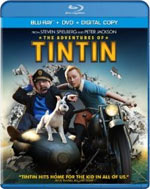
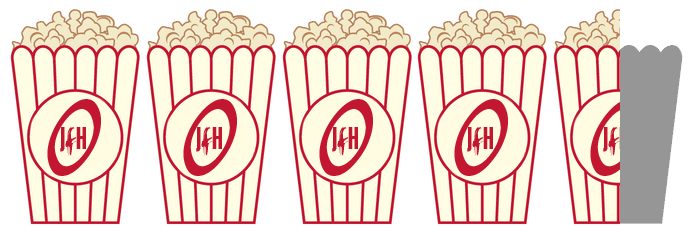
 - for adventure action violence, some drunkenness and brief smoking.
- for adventure action violence, some drunkenness and brief smoking.
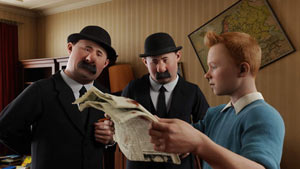 From Academy Award®-winning filmmakers Steven Spielberg and Peter Jackson comes the epic adventures of Tintin. Racing to uncover the secrets of a sunken ship that may hold a vast fortune -- but also an ancient curse -- Tintin and his loyal dog Snowy embark on an action-packed journey around the world that critics are calling "fun for the whole family." (ABC-TV Chicago)
(from Paramount Pictures)
From Academy Award®-winning filmmakers Steven Spielberg and Peter Jackson comes the epic adventures of Tintin. Racing to uncover the secrets of a sunken ship that may hold a vast fortune -- but also an ancient curse -- Tintin and his loyal dog Snowy embark on an action-packed journey around the world that critics are calling "fun for the whole family." (ABC-TV Chicago)
(from Paramount Pictures)
While I have grown up with a pretty decent knowledge of cartoons and films of old--at least probably more than the average person my age--one series that somehow escaped me entirely was The Adventures of Tintin. This was a series of "comic albums" created by a Belgian artist named Georges Remi, who created the series under the pen name of Hergé. The Adventures of Tintin launched in 1929 and was a huge hit in many countries and in several forms of media throughout the years. Even in the early 90's, the show was made into a successful cartoon show and has finally been brought back to life by the visions of filmmakers Steven Spielberg and Peter Jackson.
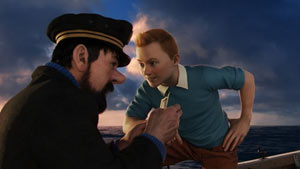 The Adventures of Tintin marks the animated and 3D debuts from Steven Spielberg. The story follows adventurer/journalist Tintin, who is already established in his world (in other words, this isn't an origin story) as he chases the story of a ship called the "Unicorn" and a legendary treasure it left behind. In his travels, he meets a drunkard sea captain named Haddock and the two link up to follow the evil and mysterious Sakharine on an adventure-filled journey to find the treasure before he does. Spielberg employs the motion capture technology to bring the world of Tintin to life in a way that not even Robert Zemeckis--the visionary behind such technology--has been able to do so effectively.
The Adventures of Tintin marks the animated and 3D debuts from Steven Spielberg. The story follows adventurer/journalist Tintin, who is already established in his world (in other words, this isn't an origin story) as he chases the story of a ship called the "Unicorn" and a legendary treasure it left behind. In his travels, he meets a drunkard sea captain named Haddock and the two link up to follow the evil and mysterious Sakharine on an adventure-filled journey to find the treasure before he does. Spielberg employs the motion capture technology to bring the world of Tintin to life in a way that not even Robert Zemeckis--the visionary behind such technology--has been able to do so effectively.
The way that Spielberg and Jackson have created such photorealistic animation is mindboggling. While watching the film for the first time on Blu-Ray (I didn't see it in the theaters), I was unsure of whether or not the animation was done via motion capture or not. I wasn't surprised to learn that it was, since some of the way that people moved and even much of the detail in the actual "acting" of the animated characters felt and looked so real. There were still plenty of moments where a character's movement or expression felt synthetic enough to wrench you out of accepting what you're watching as really real, but this may be the best motion capture animation I've seen yet. The character that looks most realistic is Tintin himself. Played by Jamie Bell, Tintin resembles the simple caricature that the original comic book character was portrayed as, but bears facial features that look amazingly realistic. Nearly every other character in the film, however, has a cartoony, stylized look to them with detail to make them fit into this more photorealistic world. They don't look like they could exist in the real world, but Tintin's representation, however, does.
The acting performances are wonderfully captured and translated into this spirited story. Bell, who's a pretty reliable young actor--but I've often see play anything but such a lighthearted and joyful character as this one--does an excellent job bringing Tintin to life. I'm unfamiliar with the source material, but as someone viewing The Adventures of Tintin for what it is, I really liked what Bell did with the character. Andy Serkis proves yet again how phenomenal of an actor he is. Haddock is a pretty adult character for a family film as this one as he's frequently drunk and struggling with whether or not to actually sober up (as per Tintin's encouragement to do so). This struggle over alcoholism brings some depth to Haddock, and Serkis is just fantastic at making Haddock such a colorful and fun character to watch. Daniel Craig voices the film's villain, Sakharine, and does so almost unrecognizably. Craig often mumbles or is soft spoken in the roles I've seen him in (Cowboys & Aliens, the Bond films), and here he's pretty forceful and intimidating. At first, you're not quite sure if he's up to no good or not, but it isn't long before his true intentions are revealed. Lastly, Simon Pegg and Nick Frost (a duo that has been seen in several films, from Sean of the Dead to Hot Fuzz) pose as two bumbling Interpol officers and are a fine addition of talent to a great cast.
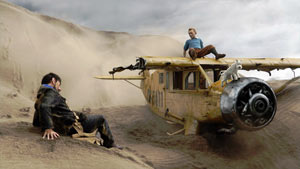 The story of The Adventures of Tintin is a fun one. Any fan of the adventure genre--from treasure hunting to mystery and even murder--should appreciate what Spielberg has done here. Spielberg is no stranger to the genre either. After four Indiana Jones installments, the filmmaker has a pretty good handle on the genre. In 2008, he released the fourth Indy film and went on to begin the motion capture filming for this movie the following year (it took two years to complete the animation for Tintin after the motion capture was done), so the fact that Tintin feels a lot like an Indiana Jones adventure is probably no coincidence. Also, Spielberg once again teams with his longtime collaborator John Williams for the film's music and a lot of the globetrotting brings out musical cues and influences that frequently reminded me of one of my all-time favorite films, Indiana Jones and the Last Crusade--in a very good way, of course. While Williams, arguably, hasn't been making as many memorable movie themes as he has in the past, he still provided a strong score for Tintin that just helped boost the classic feel that the movie possesses. While absurdity has creeped into Spielberg's live action adventure films (um... nuking the fridge and swinging with monkeys, anyone?), animation does allow even more of this to be possible. The only real eye-rolling moment that comes to mind, however, is in a whimsical chase scene near the climax of the film where Tintin flawlessly rides a motorcycle that breaks apart at one point, keeping its handlebars still in his hands, and throws him onto a clothesline or wire in the air, which allows him to use the handlebars as sort of a zipline. He then ends up grabbing on to some kind of paper lamp on another wire before neatly landing onto a balcony and running back outside to continue the chase. It's silly, and all in good fun of course, but it did pull me out of the sense of reality the movie otherwise likes to shoot for (save for some intentional bumbling comedy from Thompson and Thomson. However, nothing in the film comes even remotely close to the silliness of the aforementioned Crystal Skull moments).
The story of The Adventures of Tintin is a fun one. Any fan of the adventure genre--from treasure hunting to mystery and even murder--should appreciate what Spielberg has done here. Spielberg is no stranger to the genre either. After four Indiana Jones installments, the filmmaker has a pretty good handle on the genre. In 2008, he released the fourth Indy film and went on to begin the motion capture filming for this movie the following year (it took two years to complete the animation for Tintin after the motion capture was done), so the fact that Tintin feels a lot like an Indiana Jones adventure is probably no coincidence. Also, Spielberg once again teams with his longtime collaborator John Williams for the film's music and a lot of the globetrotting brings out musical cues and influences that frequently reminded me of one of my all-time favorite films, Indiana Jones and the Last Crusade--in a very good way, of course. While Williams, arguably, hasn't been making as many memorable movie themes as he has in the past, he still provided a strong score for Tintin that just helped boost the classic feel that the movie possesses. While absurdity has creeped into Spielberg's live action adventure films (um... nuking the fridge and swinging with monkeys, anyone?), animation does allow even more of this to be possible. The only real eye-rolling moment that comes to mind, however, is in a whimsical chase scene near the climax of the film where Tintin flawlessly rides a motorcycle that breaks apart at one point, keeping its handlebars still in his hands, and throws him onto a clothesline or wire in the air, which allows him to use the handlebars as sort of a zipline. He then ends up grabbing on to some kind of paper lamp on another wire before neatly landing onto a balcony and running back outside to continue the chase. It's silly, and all in good fun of course, but it did pull me out of the sense of reality the movie otherwise likes to shoot for (save for some intentional bumbling comedy from Thompson and Thomson. However, nothing in the film comes even remotely close to the silliness of the aforementioned Crystal Skull moments).
The content of The Adventures of Tintin was a bit of a surprise to me. The language is almost non-existent with a use of "swear to G-d" and one use of "d*mned" by Tintin, while the rest of the content concerns can be chalked up to frequent and almost relentless action violence. The worst of the instances comes when a man is gunned down during a drive-by shooting and he falls lifelessly to the floor. We then see him lying there with some blood splattered around him and blood on his hands as he tries to write a message in his blood on a nearby newspaper. Other scenes involve lots of shooting, punching, characters being pushed around, and even a scene where an unconscious Tintin almost slides headfirst into a spinning airplane propeller blade. Even more action violence is shown in flashbacks involving two pirate ships going at each other. In this sequence, we see lots of swordfighting, some cannonfire and gunfire, and lots of slicing and stabbing at each other (killing pirates left and right). It all adds up to some pretty intense violence that may surprise some parents and scare younger viewers. As an action adventure film, however, it's mostly nongraphic violence that comes with the territory, but does seem pretty rough for a family film.
The Adventures of Tintin was a great surprise. It's loaded with action and enough mystery and treasure-seeking to appease the adventure genre fan. Beautifully animated and expertly acted and directed, The Adventures of Tintin is a wonderful start to what could be a budding new (or revitalized) franchise. The film ends with a setup for an already announced sequel, and I'm really looking forward to seeing where Spielberg and Jackson take Tintin--and us--next!
- John DiBiase (reviewed: 3/11/12)
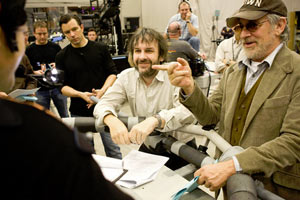 The Adventures of Tintin makes its Blu-Ray/DVD debut as a Blu-Ray/DVD/Digital Copy combo pack, a 3D BD/BD/DVD/Digital Copy Combo, and standard DVD. The Blu-Ray transfer of the film looks really excellent. I had accidentally popped the DVD copy in by mistake (since it was in the prominent place in the case) and was shocked by how NOT clear the film looked. When I realized it must be the DVD I put in, I made the switch and the difference in detail is considerable. The animation team did a truly incredible job. I haven't seen the film in 3D, but Spielberg presents the movie in a way that it probably would be best to see in 3D if possible. Camera angles and action pop right out at the viewer, so in 2D, some of it just looks a little goofy. But overall, it hardly ruins the experience at all; it would just be best to view it in 3D to be able to fully appreciate what Spielberg was trying to accomplish here.
The Adventures of Tintin makes its Blu-Ray/DVD debut as a Blu-Ray/DVD/Digital Copy combo pack, a 3D BD/BD/DVD/Digital Copy Combo, and standard DVD. The Blu-Ray transfer of the film looks really excellent. I had accidentally popped the DVD copy in by mistake (since it was in the prominent place in the case) and was shocked by how NOT clear the film looked. When I realized it must be the DVD I put in, I made the switch and the difference in detail is considerable. The animation team did a truly incredible job. I haven't seen the film in 3D, but Spielberg presents the movie in a way that it probably would be best to see in 3D if possible. Camera angles and action pop right out at the viewer, so in 2D, some of it just looks a little goofy. But overall, it hardly ruins the experience at all; it would just be best to view it in 3D to be able to fully appreciate what Spielberg was trying to accomplish here.
Toasting Tintin: Part 1 (1:24) - This is a short video from January 23, 2009, the first day of Performance Capture filming where Steven reads a letter from Hergé's widow, Fanny, giving the cast and crew her blessing. They then all toast to Hergé and drink some champagne.
The Journey to Tintin (8:54) - Here Spielberg says he first learned of Tintin while reading a French review in 1981 of his film Raiders of the Lost Ark! The reviewer kept comparing Raiders to "Tintin," but he'd never heard of it before and assumed it was a French word. He then tells the story of how he had begun dialogging with Hergé back in 1983 about eventually making a Tintin film, but the creator died soon after they started talking about it. Then, several years ago, he sought out Peter Jackson about his production team possibly doing a fully CG rendering of Snowy if Spielberg were to make a live action Tintin film. Spielberg includes here Jackson's test footage of Snowy with a live actor and then Jackson himself as Haddock in the shot with a digital Snowy. This is a must-watch segment!
The World of Tintin (10:46) explains the beginnings of Tintin and Hergé's creation of him. We get to hear a little from Jamie Bell and Simon Pegg about their experiences with Tintin and Jackson explains why the film does not give any background at all on the iconic character. Hergé had actually never explained Tintin's origins, so Jackson wanted to honor that by not trying to explain it in the film (which is something I had wondered about).
The Who's Who of Tintin (14:18) is a wonderful look at each of the cast members, their performances, and the characters in the series. It's another excellent, must-see featurette.
Tintin: Conceptual Design (8:38) - Jackson and Spielberg did most all of their designing of the film's look together via webcasts, with Jackson being in New Zealand and Spielberg being in the U.S. It then goes into detail of how they designed the "sets" and look of the film based on Hergé's work and then how they were able to create digital sets for the actors to perform in and actually see their performance in while acting it out on the motion capture stage.
Tintin: In The Volume (17:54) - This opens with a great example of Spielberg directing on the digital set, called a "Volume." It's ultra fascinating because they show just how it works to film in this small digital-capturing space. This is an in-depth featurette that takes a significant look into filming in a 3D space and how this experience differed from other films and techniques Spielberg had worked on before.
Snowy: From Beginning To End (10:11) - Here we learn that Tintin's dog, Snowy, was originally named Milou, but was changed when they brought the comics to the U.S. They then show how Snowy was represented during filming--since he was done entirely digital--and how they brought him to the screen.
Animating Tintin (13:05) focuses even more on the motion capture and how it took two years to fully animate the motion capture footage. They focus on the lighting and details and how they reworked Spielberg's handheld shots with completed, smooth animation. It's a really intriguing process.
Tintin: The Score (7:01) is dedicated to John Williams' score for Tintin, and how it's Williams' first ever animated film score. It's neat to learn that Williams had to create the score to the film with only a rough print to watch while scoring.
Collecting Tintin (3:58) focuses on the collectibles made for the film, particularly some statue figurines they designed based on the movie renditions of the characters.
Toasting Tintin: Part 2 (3:12) - The last featurette is a video from the September 15, 2011 toast to the completion of the movie. Via webcast, Spielberg and his team toast to Jackson, Serkis and the animation crew in New Zealand. It's a great way to conclude this fantastic featurette.
- John DiBiase, (reviewed: 3/12/12)
Disclaimer: All reviews are based solely on the opinions of the reviewer. Most reviews are rated on how the reviewer enjoyed the film overall, not exclusively on content. However, if the content really affects the reviewer's opinion and experience of the film, it will definitely affect the reviewer's overall rating.
 Matthew West Performs At "CBS News Presents: A Town Hall With Erika Kirk" Matthew West Performs At "CBS News Presents: A Town Hall With Erika Kirk"Fri, 12 Dec 2025 15:50:00 EST |
 William Lee Golden and The Goldens Release New Music Video For "Old Country Church" William Lee Golden and The Goldens Release New Music Video For "Old Country Church"Fri, 12 Dec 2025 15:30:00 EST |
 Seph Schlueter Caps Breakout Year with Billboard and Mediabase Success Seph Schlueter Caps Breakout Year with Billboard and Mediabase SuccessFri, 12 Dec 2025 15:00:00 EST |
 Declarations Debuts Self Titled EP Declarations Debuts Self Titled EPFri, 12 Dec 2025 14:50:00 EST |
 Compassion Announces Hope of Heaven Tour with Jennifer Rothschild and Point of Grace Compassion Announces Hope of Heaven Tour with Jennifer Rothschild and Point of GraceFri, 12 Dec 2025 14:40:00 EST |
 New Artist Of the Year Leanna Crawford Announces The Sisterhood Tour New Artist Of the Year Leanna Crawford Announces The Sisterhood TourFri, 12 Dec 2025 14:30:00 EST |
 Tommee Profitt's The Birth Of A King Live To Return To Bridgestone Arena in 2026 Tommee Profitt's The Birth Of A King Live To Return To Bridgestone Arena in 2026Fri, 12 Dec 2025 13:30:00 EST |
 Click here All News Headlines |
Click here All News Headlines |